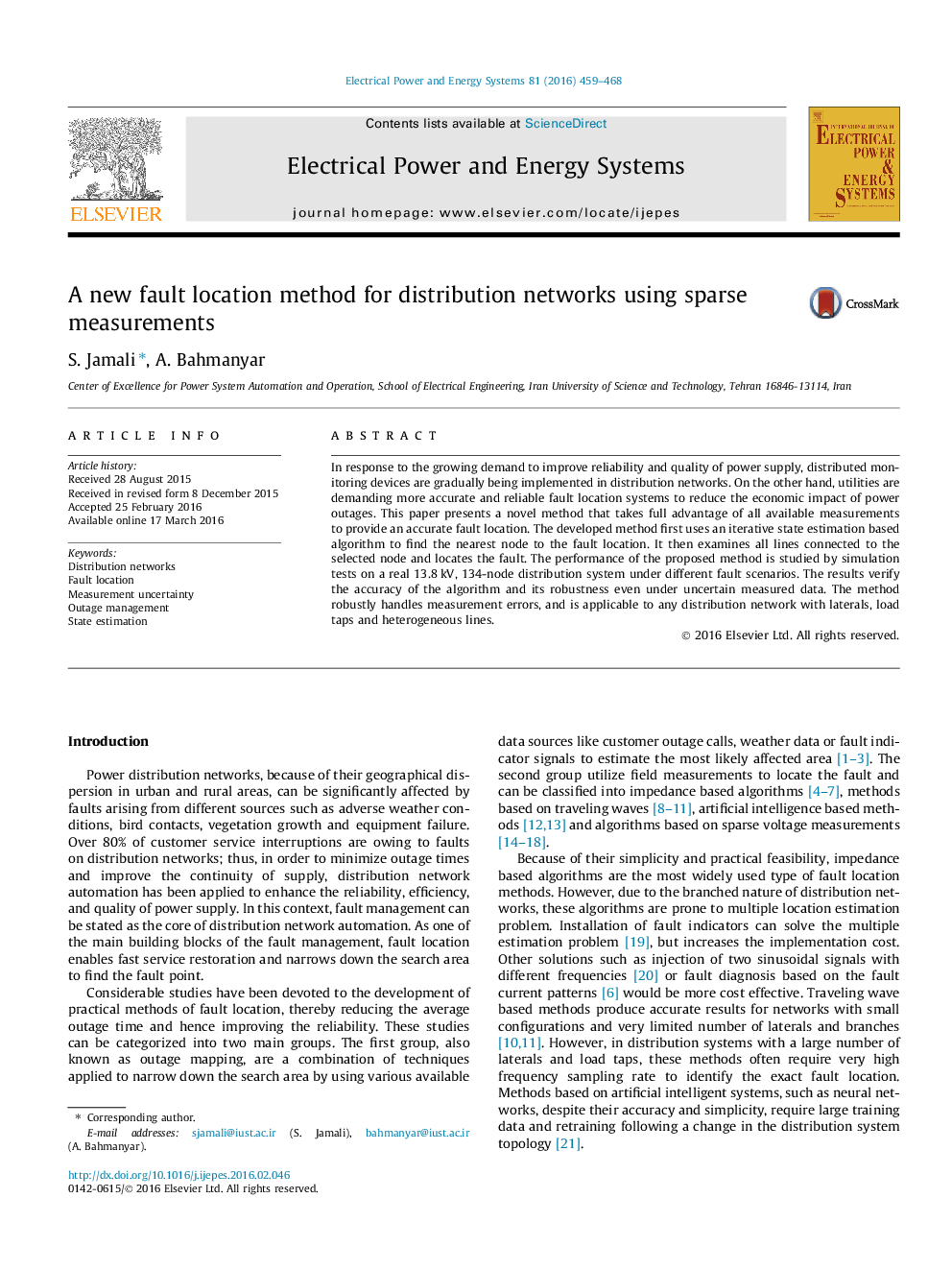| کد مقاله | کد نشریه | سال انتشار | مقاله انگلیسی | نسخه تمام متن |
|---|---|---|---|---|
| 399198 | 1438719 | 2016 | 10 صفحه PDF | دانلود رایگان |
کلید واژه ها
معرفی
برآورد حالت مبتنی بر جریان شعبه
الگوریتم
شکل 1: شرح روش پیشنهادی
آماده سازی داده های ورود
تشخیص و شناسایی داده های بد
شناسایی منطقه خطا
شکل 2: شناسایی ناحیه گسل در یک سیستم توزیع نمونه.
رتبه بندی گره ها
شکل 3. نمودار جریان الگوریتم ارزیابی گره پیشنهاد شده. خط. 3. نمودار جریان الگوریتم رتبه بندی گره پیشنهاد شده.
شناسایی خط خطا و موقعیت خطا
شکل 4. تغییر EMBED Equation.3 با حرکت خطا در طول خط.
مطالعه موردی
عملکرد تحت شرایط ایده آل
شکل 5: توپولوژي شبکه توزيع 134 گره.
شکل 6 مقادیر شاخص برای گره های مختلف برای یک خط به زمین (AG) گسل در خط 107-112 دریافت می شود.
شکل 7. مقادیر شاخص زاویه ( EMBED Equation.3 ) برای گره های تحت بررسی.
اثر اندازه گیری ولتاژ و اشتباهات تخمین بار
جدول 1 - فاصله بین نقاط خطای تخمین شده و واقعی (D) در شاخص برای خطوط تک خطی به زمین (AG)
جدول 2 - فاصله بین نقاط خطای تخمین شده و واقعی (D) در شاخص برای انواع گسل های مختلف.
جدول 3 - فاصله بین نقاط خطای تخمین شده و واقعی (D) در شاخص برای انواع گسل های مختلف به دست آمده توسط روش پیشنهاد شده در [14].
شکل 8. تفاوت بین مقادیر ولتاژ محاسبه شده و واقعی برای یک خط به خطای زمین در گره 80 با Rf = 10 Ω.
جدول 4 - فاصله بین نقاط خطای تخمین شده و واقعی (D) در متر برای خطوط تک خطی به زمین (AG) با Rf = 10 Ω (عملکرد روش پیشنهاد شده در شرایط غیر ایده آل).
شکل 9: باقی مانده های نرمال شده ولتاژ های اندازه گیری شده در حضور داده های بد در گره های 87 و 118.
جدول 5 - فاصله بین نقاط خطای تخمین شده و واقعی (D) در شاخص با استفاده از تعداد محدودی از اندازه گیری ها.
• Proposing a new state estimation based fault location method.
• The proposed method incorporates all measurements into calculations to provide the best result.
• Minimizing the impact of measurement and load estimation errors and identifying gross errors.
• Accurate results for different fault types, positions, and resistances.
In response to the growing demand to improve reliability and quality of power supply, distributed monitoring devices are gradually being implemented in distribution networks. On the other hand, utilities are demanding more accurate and reliable fault location systems to reduce the economic impact of power outages. This paper presents a novel method that takes full advantage of all available measurements to provide an accurate fault location. The developed method first uses an iterative state estimation based algorithm to find the nearest node to the fault location. It then examines all lines connected to the selected node and locates the fault. The performance of the proposed method is studied by simulation tests on a real 13.8 kV, 134-node distribution system under different fault scenarios. The results verify the accuracy of the algorithm and its robustness even under uncertain measured data. The method robustly handles measurement errors, and is applicable to any distribution network with laterals, load taps and heterogeneous lines.
Journal: International Journal of Electrical Power & Energy Systems - Volume 81, October 2016, Pages 459–468
